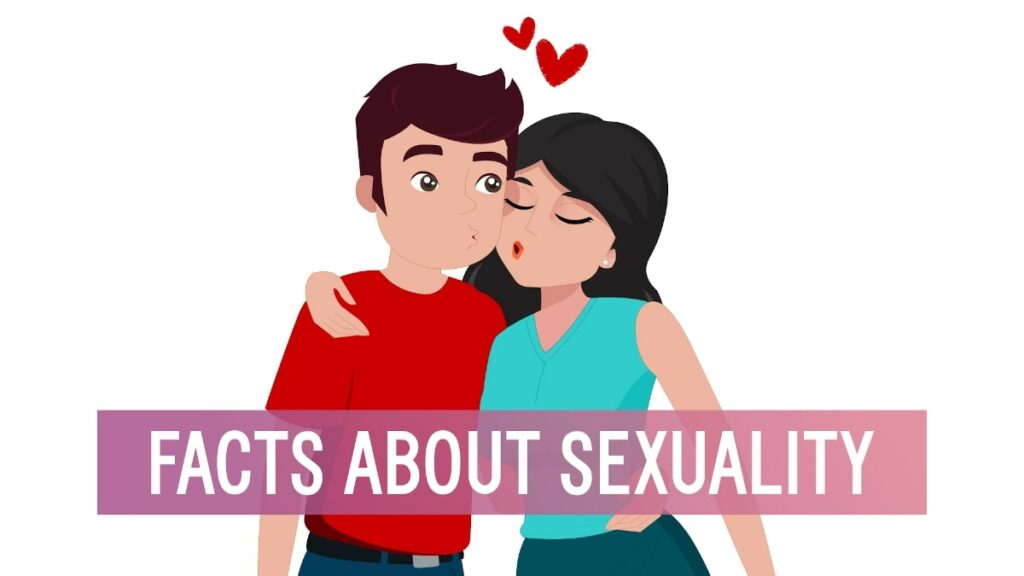
Sexuality is not about who you have sex with, or how often you have it. Sexuality is about your sexual feelings, thoughts, attractions, and behaviors towards other people. You can find other people physically, sexually, or emotionally attractive, and all those things are a part of your sexuality.
Sexuality is diverse and personal, and it is an important part of who you are. Discovering your sexuality can be a very liberating, exciting, and positive experience.
Some people experience discrimination due to their sexuality. If someone gives you a hard time about your sexuality, it’s good to talk to someone about it.
Heterosexual and Homosexual
Most people are attracted to the opposite sex – boys who like girls, and women who like men, for example. These people are heterosexual, or ‘straight’.
Some people are attracted to the same sex..they are homosexual.
‘Lesbian’ is the common term for people who identify as women and are same-sex attracted. ‘Gay’ is the most common term for people who identify as men and are same-sex attracted, although women identifying as lesbian also sometimes use this word.
Bisexual
Sexuality can be more complicated than being straight or gay. Some people are attracted to both men and women and are known as bisexual.
Bisexual does not mean the attraction is evenly weighted – a person may have stronger feelings for one gender than another. And this can vary depending on who they meet.
There are different kinds of bisexuality. Some people who are attracted to men and women still consider themselves to be mainly straight or gay. Or they might have sexual feelings towards both genders but only have intercourse with one.
Other people see sexual attraction as more grey than black and white. These people find everyday labels too rigid. Some prefer to identify as ‘queer’. And others use the term ‘pan’, or ‘pansexual’, to show they are attracted to different kinds of people no matter what their gender, identity or expression.
There are many differences between individuals, so bisexuality is a general term only.
Asexual
A person who identifies as asexual (‘ace’ for short) is someone who does not
experience, or experiences very little, sexual attraction.
Asexuality is not a choice, like abstinence (where someone chooses not to have sex with anyone, whether they are attracted to them or not). Asexuality is a sexual orientation, like homosexuality or heterosexuality. Some people may strongly identify with being asexual, except for a few infrequent experiences of sexual attraction (grey-asexuality). Some people feel sexual attraction only after they develop a strong emotional bond with someone (this is known as demisexuality). Other people experience asexuality in a range of other ways.
Sexuality and mental health
LGBTI people have an increased risk of depression, anxiety, substance abuse, homelessness, self-harming and suicidal thoughts, compared with the general population. This is particularly true of young LGBTI people who are coming to terms with their sexuality and experiencing victimization and bullying at school.
Some of the stressful experiences that can affect the mental health of an LGBTI person are:
- feeling different from other people
- being bullied (verbally or physically)
- feeling pressure to deny or change their sexuality
- feeling worried about coming out, and then being rejected or isolated
- feeling unsupported or misunderstood.
Interesting, rarely known facts about sexuality
- Homosexuality is the result of the brain’s structure. The degree of symmetry of the left and right hemispheres decides the sexual nature of a person. Another factor responsible is the nerve connections in amygdale.
- Heterosexual individuals (both male and female) tend to have more symmetrical faces than gay men and lesbians persons with a homosexual orientation are significantly more likely to be left-handed than their heterosexual counterparts.
- Besides the heterosexual and homosexual, asexual people also find a place in today’s population. They are the ones who do not desire a partnered activity.
- Eyes also tell our sexual orientation. That is through the degree of pupil’s dilation.
- Heterosexual parents carry a greater tendency to raise gay children as compared to gay parents.
- It is increasingly being seen that same-sex couples live a healthier life than ordinary couples.
- Contrary to the popular stereotype that bisexual men are just guys who are not ready to come out as gay yet, research has found evidence that male bisexuality—meaning strong physiological and psychological arousal in response to both men and women—is definitely a real thing.
- While gender nonconformity is indeed associated with homosexuality, behavioral characteristics and appearance vary considerably across both gay men and lesbians.
- Despite popular media depictions that almost universally portray gay couples in this way, there are no assigned roles in a same-sex relationship. The reality is that partners in gay and lesbian relationships tend to share responsibilities equally rather than conforming to traditional gender roles gay men do not necessarily have stronger libidos or greater sexual desire than their heterosexual counterparts.
There are several myths and misconceptions on the subject of sexuality, but the facts mentioned above are given by authorized agencies to clear the myths. These are the result of various surveys done by them.
More facts to amaze you
- A kiss between two people exchanges about ten million to a billion bacteria.
- Women can benefit through orgasms as it lowers risks of stroke, heart diseases, depression, as well as breast cancer.
- The average female orgasm lasts twenty seconds, while in males; it is of six seconds on an average. Coming to the animals, rates of homosexuality may differ quite a lot. For example, rams are species of animals that have a ratio of nine percent of its population having a same- sex preference. Similarly, twenty-three percent of the species are bisexual.
- Evolutionary theory posits that heterosexual men are attracted to women whose bodies are shaped like an hourglass and who have long, silky hair because these are signs of good health and fertility.
Benefits of sex
There are several facts about sexuality that show how beneficial sexual activity can be. Here we go:
- It reduces stress levels.
- As per research and studies, fewer working people have been found to have more sex and vice-versa.
- The Heart gets better with sexual activity. It mainly saves men from a heart attack at a considerable rate.
- Sexual activity further helps protect against cancer, relieve pain in women, and improve sperm quality.
Conclusion
Sexuality is a gift of nature to humans. It has the power to change lives. However, before engaging in any certain feeling or activity, you should always understand the real meaning of sexuality.
Special Thanks to Dr Niraj Jadav for the expert advice.







